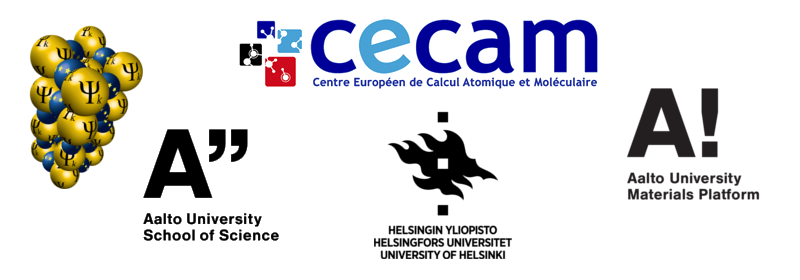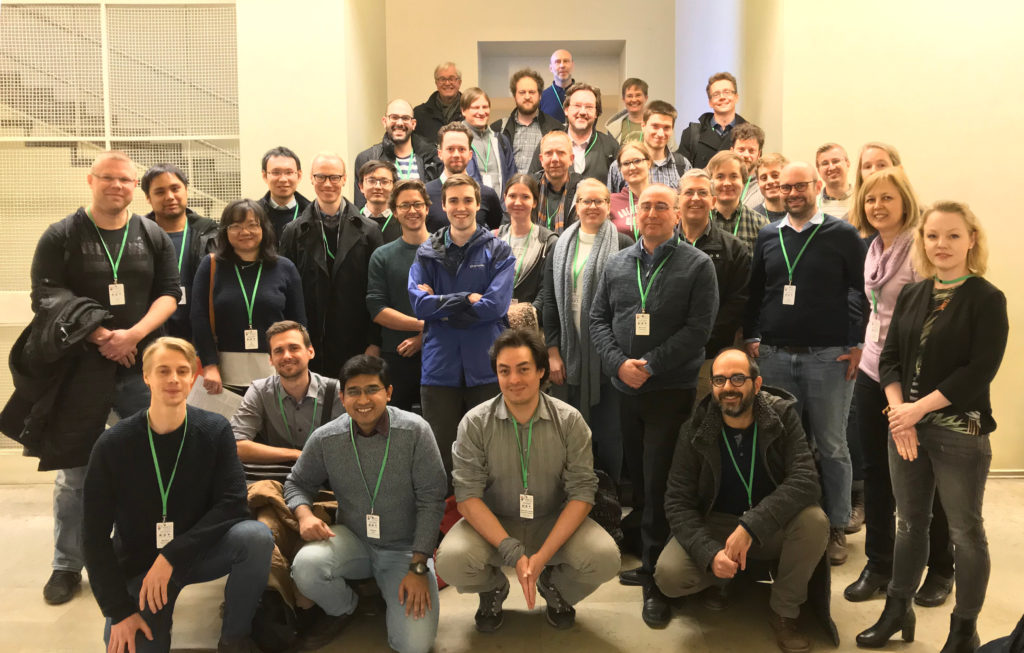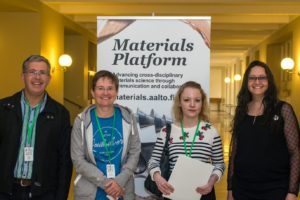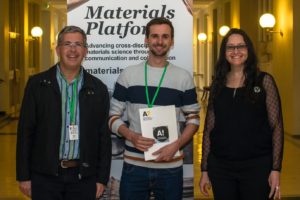General comments
The Atomistic Simulation of Carbon and related Materials (ASCM2019) workshop (ascm2019.nanocarbon.fi) took place in Helsinki, Finland between the 10th and 12th of April 2019. The workshop venue was the historical main building of the University of Helsinki. The event was jointly organized by Flyura Djurabekova (University of Helsinki), Volker Deringer (University of Cambridge) and Miguel Caro (Aalto University).
A total of circa 45 participants (mostly from Europe but also from overseas) met at the heart of Helsinki for three days of discussion on the state of the art and future prospects of atomistic simulation of pure carbon compounds and nanostructures, functionalized carbon materials, carbon-containing molecules and silicon/SiC alloys. Focus topics with strong presence at the workshop were atomistic modeling of graphene and carbon nanotubes, amorphous carbon, molecular dynamics simulations of high-energy/irradiation effects, development and benchmarking of interatomic potentials and, prominently, machine learning applied to atomistic simulations in general and carbon science in particular. The oral sessions featured a nice combination of established and early-career researchers.
While density-functional-theory-based methods are still predominant in the community, the importance of van der Waals corrections (especially important for carbon nanostructures) and the acceleration of molecular dynamics through machine learning are gaining prominence. In particular, the main application of machine learning methodologies is the interpolation of potential energy surfaces, but also other applications, such as for data classification and visualization are starting to take root. Simulation of spectroscopic techniques, namely Raman, NMR and X-ray spectroscopies, is also gaining momentum for verifying and predicting structural models of materials. Finally, multiscale modeling where different levels of theory are mixed (e.g., to parametrize atomistic force fields from electronic structure calculations) retains its validity, in particular in the wake of machine learning potentials which feed on ab initio data.
Funding
The workshop was funded by the Finnish CECAM node, the Psi-K Network, Aalto University’s CMMP network and University of Helsinki’s MATRENA. In addition, the Aalto University Materials Platform sponsored “best talk” and “best poster” prizes.
Program
| Wednesday 10th April Room 12 |
Thursday 11th April Room 5 |
Friday 12th April Room 5 |
|
| 9:00 – 9:30 | Registration, welcome and coffee | Coffee | Coffee |
| 9:30 – 10:30 | Invited Lecture 1: Chaired by Miguel Caro Marika Schleberger |
Session 1: Chaired by Alexandre Tkatchenko 9:30 – 10:10
10:10 – 10:30 |
Session 5: Chaired by Arkady Krasheninnikov 9:30 – 10:10
10:10 – 10:30 |
| 10:30 – 11:00 | Coffee break | Coffee break | Coffee break |
| 11:00 – 12:00 | Invited Lecture 2: Chaired by Miguel Caro Nigel Marks |
Session 2: Chaired by Gábor Csányi 11:00 – 11:40
11:40 – 12:00 |
Session 6: Chaired by Lars Pastewka 11:00 – 11:40
11:40 – 12:00 |
| 12:00 – 14:00 | Lunch | Lunch | Lunch |
| 14:00 – 15:00 | Invited Lecture 3: Chaired by Hannes Jónsson Alexandre Tkatchenko |
Session 3: Chaired by Nigel Marks 14:00 – 14:40
14:40 – 15:00 |
Session 7: Chaired by André Schleife 14:00 – 14:40
14:40 – 15:00 |
| 15:00 – 15:30 | Coffee break | Coffee break | Coffee break |
| 15:30 – 16:30 | Invited Lecture 4: Chaired by Hannes Jónsson Gábor Csányi |
Session 4: Chaired by Marika Schleberger 15:30 – 16:10
16:10 – 16:30 |
Session 8: Chaired by Flyura Djurabekova 15:30 – 15:50
15:50 – 16:10
16:10 – 16:30 |
| 16:30 – 17:30 | Special session: Status and prospects of modelling carbon materials Chaired by Volker Deringer and open for contributions from the audience |
2-minute poster presentations | Prizes and farewell (second floor) |
| 17:30 – 18:00 | Poster session (second floor) |
||
| 18:00 – 19:00 | Dinner at Bryggeri | ||
| 19:00 – 21:00 |
List of participants
Organizers
| Name | Institution | Contact |
|---|---|---|
| Flyura Djurabekova | University of Helsinki (Finland) | [email protected] |
| Volker Deringer | University of Cambridge (UK) | [email protected] |
| Miguel Caro | Aalto University (Finland) | [email protected] [email protected] Google Scholar profile |
Invited speakers
See also invited speakers page.
| Name | Institution | Contribution | Contact |
|---|---|---|---|
| Gábor Csányi | University of Cambridge (UK) | Invited lecture: Machine learned interatomic potentials for carbon and other elemental materials (abstract) | |
| Hannes Jónsson | University of Iceland | Invited talk: Is N- and B-doped graphene an efficient catalyst for the oxygen reduction reaction? (abstract) | |
| Arkady Krasheninnikov | Helmholtz-Zentrum Dresden-Rossendorf (Germany) | Invited talk: Defects and new phases in graphene and related systems: insights from multi-scale atomistic simulations (abstract) | Website @Helmholtz-Zentrum Dresden-Rossendorf Website @ Aalto University |
| Tomi Laurila | Aalto University (Finland) | Invited talk: Amorphous carbon materials – experiments and computational studies augmented by machine learning (abstract) | |
| Nigel Marks | Curtin University (Australia) | Invited lecture: Transferability of Carbon Interatomic Potentials: Lessons from Amorphous Carbon & Graphitization (abstract) | [email protected] |
| Risto Nieminen | Aalto University (Finland) | Invited talk: Modelling the growth and processing of tetrahedral amorphous carbon (abstract) | |
| Kai Nordlund | University of Helsinki (Finland) | Invited talk: Enabling more efficient antihydrogen production: MD simulation of transmission of antiprotons through thin carbon foils (abstract) | |
| Lars Pastewka | University of Freiburg (Germany) | Invited talk: Plastic flow of amorphous carbon and the activation of shear transformations (abstract) | [email protected] Google Scholar |
| Marika Schleberger | University of Duisburg-Essen (Germany) | Invited lecture: Ion Irradiation of 2D Materials: What we can learn from experiments (and what we cannot learn) (abstract) | Website |
| André Schleife | University of Illinois at Urbana-Champaign (USA) | Invited talk: Strain-dependent dielectric screening in a carbon nanotube and electronic response of graphene to proton irradiation (abstract) | Website |
| Alexandre Tkatchenko | University of Luxembourg | Invited lecture: Non-Covalent Interactions in Carbon-based Materials |
All other participants
| Name | Institution | Contribution | Contact |
|---|---|---|---|
| Anja Aarva | Aalto University (Finland) | Talk: Understanding X-ray spectroscopy of carbonaceous materials by combining Density Functional Theory with Machine Learning (abstract) | [email protected] |
| Vanessa Angenent | Ruhr-Universität Bochum (Germany) | Poster: Computational Construction of atomistic non-planar char models (abstract) | [email protected] |
| Ekaterina Anikina | South Ural State University (Russia) | Poster: Carbon nanomaterials for hydrogen storage application: DFT modelling (abstract) | [email protected] |
| Bernardo Barbiellini | Lappeenranta University of Technology (Finland) | Poster: Understanding Iron-based catalysts with efficient Oxygen Reduction Activity from First Principle calculations (abstract) | [email protected] Google Scholar profile |
| Amirhossein Bayani | Uppsala University (Sweden) | [email protected] Google Scholar profile | |
| Xi Chen | Aalto University (Finland) | ||
| Deb Sankar De | University of Basel (Switzerland) | Talk: Comparison of potential energy surface between carbon based and silicon based fullerene configurations (abstract) | [email protected] |
| Francisco Javier Dominguez Gutierrez | Max Plank Institute for Plasma Physics (Germany) | Poster: MD simulation for hydrogen capture by boron-doped fullerenes at low energy collisions (abstract) | [email protected] |
| Lincan Fang | Aalto University (Finland) | ||
| Fredric Granberg | University of Helsinki (Finland) | [email protected] Website | |
| Ali Hamedani | University of Helsinki (Finland) | [email protected] | |
| Markus Hirvensalo | Aalto University (Finland) | Poster: Developing computational tools for the core-level spectroscopy of amorphous carbon (abstract) | |
| Damjan Iveković | Ruđer Bošković Institute (Croatia) | Poster: Exploring effects of the swift heavy ion beam charge state on the ion track production in graphene (abstract) | [email protected] Website |
| Marko Karlušić | Ruđer Bošković Institute (Croatia) | Talk: Opportunities for swift heavy ion irradiation of graphene at RBI (abstract) | |
| Dimitrios Kilymis | CIRIMAT, Université de Toulouse (France) | Poster: Understanding the structure of disordered carbons through calculations of NMR spectra (abstract) | Website |
| Susanne Leitherer | Technical University of Denmark | Talk: A first-principles study of current-induced forces in carbon-based nanojunctions (abstract) | |
| Jian Liu | Nanjing University of Aeronautics and Astronautics (China) | Poster: Plasma deposition and swift heavy ion irradiation effects of diamond-like-carbon coating multilayer graphene: A molecular dynamics simulation (abstract) | [email protected] |
| James McHugh | Loughborough University (UK) | Poster: Ab-Initio Simulation of Fission Product Diffusion in Graphene & Graphite (abstract) | [email protected] |
| Alberto Milani | Politecnico di Milano (Italy) | Talk: DFT simulations of the Raman response of sp carbon-atom wires: from electron-phonon coupling to charge transfer effects (abstract) | [email protected] Google Scholar profile |
| Heikki Muhli | Aalto University (Finland) | ||
| Johannes Nokelainen | Lappeenranta-Lahti University of Technology (Finland) | Poster: Gate-tunable magnetism of C adatoms on graphene (abstract) | [email protected] |
| Teerachote Pakornchote | Chulalongkorn University (Thailand) | Poster: Ab-initio study on stabilization and intrinsic properties of bilayer graphene forming sp3 bonding (abstract) | [email protected] |
| Chao Peng | University of Southampton (UK) | Poster: New insight into lithium intercalation and doping implications at edged graphite in Lithium-Ion Battery (abstract) | [email protected] |
| Patrick Rinke | Aalto University (Finland) | [email protected] | |
| Franz Martin Rohrhofer | Graz University of Technology (Austria) | Poster: Machine learning of DFT internal energies for carbon and boron structures (abstract) | [email protected] |
| Patrick Rowe | University College London (UK) | Talk: machine learning potential for carbon using the Gaussian approximation potential framework (abstract) | [email protected] |
| Santanu Saha | Graz University of Technology (Austria) | Talk: Structural map of elemental Carbon (abstract) | [email protected] Google Scholar profile |
| Jörg Schuster | Fraunhofer ENAS (Germany) | Talk: Simulation of electron transport in realistic carbon nanostructures: the role of defects and the conductivity of macro materials (abstract) | [email protected] Google Scholar profile |
| Yiwei Sun | Queen Mary University of London (UK) | Poster: π-electrons of Multi-layer Graphene Under Compression (abstract) | [email protected] Google Scholar profile |
| Harry Tunstall | The University of Warwick (UK) | Poster: Towards a General-Purpose Interatomic Potential for Silicon Carbide (abstract) | [email protected] |
| Matthias Vandichel | Aalto University (Finland) | [email protected] Google Scholar profile | |
| Henrique Vazquez Muiños | University of Helsinki (Finland) | Talk: Early electron dynamics in graphene after Swift Heavy Ion impacts (abstract) | [email protected] |
| Max Veit | École Polytechnique Fédérale de Lausanne (Switzerland) | Talk: Molecular and condensed-phase machine learning potentials for alkanes (abstract) | [email protected] Website |




